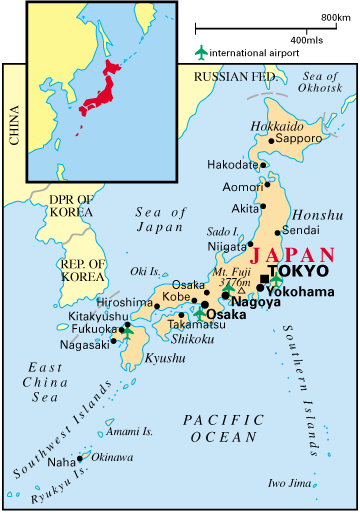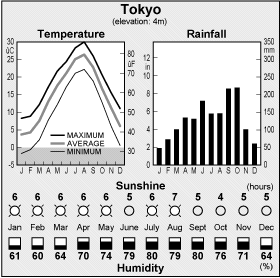General Information

Area: 377,864 sq km
Population: 127.9 million (UN, 2005)
Population Density: 338.48 per sq km
Capital: Tokyo
Capital Population: 8.1 million (2000)
Geography: Japan is separated from the Asian mainland by 160km (100 miles) of sea. About 70 per cent of the country is covered by hills and mountains, a number of which are active or dormant volcanoes. A series of mountain ranges runs from northern Hokkaido to southern Kyushu. The Japanese Alps (the most prominent range) run in a north-south direction through central Honshu. The highest mountain is Mount Fuji at 3776m. Lowlands and plains are small and scattered, mostly lying along the coast and composed of alluvial lowlands and diluvial uplands. The coastline is very long in relation to the land area, and has very varied features. The deeply indented bays with good natural harbours tend to be adjacent to mountainous terrain.
Government: Constitutional monarchy.
Head of State: Emperor Akihito since 1989.
Head of Government: After scraping through the November 2000 general election, the LDP (Liberal Democratic Party, or Jiyu Minshu-to) was about to recall their leader, the deeply unpopular ex-finance minister Ryutaro Hashimoto, when an unlikely would-be saviour appeared in the form of Junichiro Koizumi, a former minister with a huge popular following by virtue of his flamboyant personal style and evident determination to break with the past. The LDP's overwhelming victory in upper house parliamentary elections in July 2001 secured his position. In October 2002, the Koizumi government finally unveiled plans to tackle the country's financial crisis. Barring unemployment, which reached an unprecedented 6 per cent, the programme had begun to show results by late 2003 as Government measures began to take effect. This was the main reason for Koizumi's successful re-election campaign that saw the LDP returned as the largest party. Koizumi also won an overwhelming victory in lower house elections in September 2005, giving his party and its coalition ally a key two-thirds majority in the new Parliament. Mr Koizumi promised to push on with post office reform, which he had put at the heart of his campaign. He said he still intended to step down in September 2006, when his term as President of the ruling Liberal Democratic Party (LDP) ends.
The Japanese parliament is the bicameral Kokkai (or Diet). The upper house (Sangi-in) has 252 members directly elected from constituencies for six-year terms (half of which are renewed every three years). The lower house (Shugi-in) has 500 members elected for four-year terms partly by single-seat constituencies, partly by proportional representation. The Diet approves the appointment of a Prime Minister who holds executive power with the assistance of a cabinet of ministers. The appointment of the Prime Minister is formally entrusted to the Emperor who is head of State but has negligible constitutional powers.
Language: Japanese is the official language.
Religion: Shintoism and Buddhism (most Japanese follow both religions) with a Christian minority. In Okinawa, however, people believe in Niraikanai, the realm of the dead beyond the sea.
Social Conventions: Japanese manners and customs are vastly different from those of Western people. A strict code of behaviour and politeness is recognised and followed by almost all Japanese. However, they are aware of the difference between themselves and the West and therefore do not expect visitors to be familiar with all their customs but expect them to behave formally and politely. A straightforward refusal does not form part of Japanese etiquette. A vague 'yes' does not really mean 'yes' but the visitor may be comforted to know that confusion caused by non-committal replies occurs between the Japanese themselves. Entertaining guests at home is not as customary as in the West, as it is an enterprise not taken lightly and the full red-carpet treatment is given. Japanese men are also sensitive lest their wives be embarrassed and feel that their hospitality is inadequate by Western standards; for instance, by the inconvenience to a foreign guest of the custom of sitting on the floor. Bowing is the customary greeting but handshaking is becoming more common for business meetings with Westerners. The honorific suffix san should be used when addressing all men and women; for instance Mr Yamada would be addressed as Yamada-san. When entering a Japanese home or restaurant it is customary to remove shoes. Table manners are very important, although the Japanese host will be very tolerant towards a visitor. However, it is best if visitors familiarise themselves with basic table etiquette and use chopsticks. It is customary for a guest to bring a small gift when visiting someone's home. Exchange of gifts is also a common business practice and may take the form of souvenir items such as company pens, ties or high-quality spirits. Smoking is only restricted where notified.


Currency: Japan has a strong cash culture, and it is usual to see people carrying large amounts of cash with them because of the low crime rate. It is only recently that credit cards have begun to become more popular. However, travellers may still encounter difficulties with foreign credit cards. ATMs are widely available although many do not accept foreign credit or debit cards, and are harder to find outside of towns. They only operate during normal banking hours and weekend services can be restricted to Saturday morning. ATMs are available in towns and they are generally open Mon-Fri 0700-2300, Sat-Sun 0900-1900. Citibank machines also accept foreign credit cards and are often open 24 hours.
Banking hours: Mon-Fri 0900-1500.
Exchange rate indicator

Climate: Except for the Hokkaido area and the subtropical Okinawa region, the weather is mostly temperate, with four seasons. Winters are cool and sunny in the south, cold and sunny around Tokyo (which occasionally has snow), and very cold around Hokkaido, which is covered in snow for up to four months a year. Summer, between June and September, ranges from warm to very hot, while spring and autumn are generally mild throughout the country. Rain falls throughout the year but June and early July is the main rainy season. Hokkaido, however, is much drier than the Tokyo area. Rainfall is intermittent with sunshine. Typhoons are only likely to occur in September or October but rarely last more than a day.